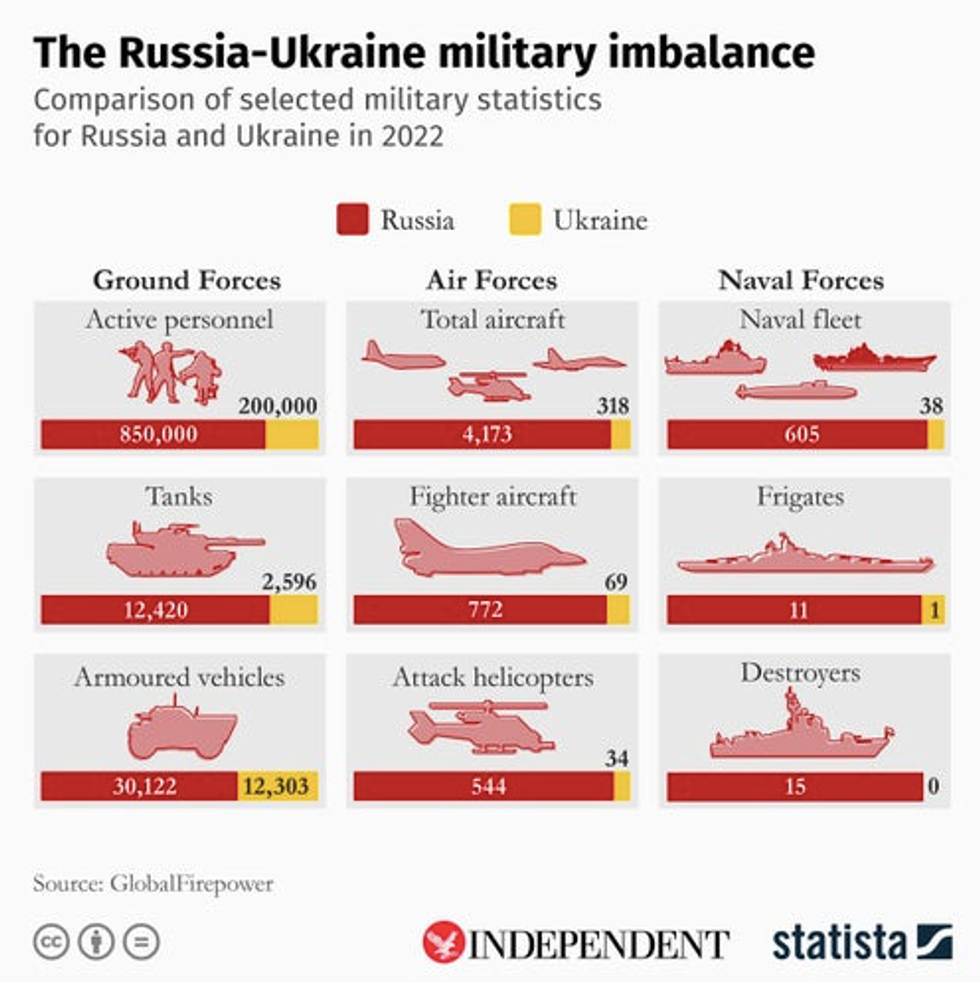Russian president Vladimir Putin announced that Russia will conduct a military operation in eastern Ukraine.
In a televised address early on Thursday morning, Putin said the action comes in response to threats coming from Ukraine.
He said they do not plan to occupy Ukraine, and said the operation was to ensure a "demilitarisation" of Ukraine, as well as to "de-Nazify" the country.
Putin also warned other countries that any attempt to interfere with the Russian action would lead to “consequences they have never seen”.
The announcement came just after airspace over all of Ukraine was shut down to civilian air traffic, and at the same time as an emergency meeting of the UN Security Council was taking place.
Ukrainian president Volodymyr Zelensky announced that martial law was being imposed across Ukraine and cut diplomatic ties with Russia.
Zelensky also called on fit military-aged men to defend the country, and said everyone who comes forward will be issued weapons.
US President Joe Biden has denounced Russia’s decision to conduct a military operation in Ukraine as an “unprovoked and unjustified attack”.
President Zelenskyy reached out to me tonight and we just finished speaking. I condemned this unprovoked and unjustified attack by Russian military forces. I briefed him on the steps we are taking to rally international condemnation, including tonight at the UN Security Council.— President Biden (@President Biden) 1645679991
Prime Minister Boris Johnson has also condemned the move, saying: “President Putin has chosen a path of bloodshed and destruction by launching this unprovoked attack on Ukraine.”
I am appalled by the horrific events in Ukraine and I have spoken to President Zelenskyy to discuss next steps. \n\nPresident Putin has chosen a path of bloodshed and destruction by launching this unprovoked attack on Ukraine. \n\nThe UK and our allies will respond decisively.— Boris Johnson (@Boris Johnson) 1645678431
To put the conflict in context, here are three maps and graphs that help explain what’s going on:
The lay of the land

Last week The Independent reported that Russia had amassed over 100,000 troops near the Ukrainian border. This has nowgrown to 200,000, according to Zelensky, along with thousands of combat vehicles.
To the north of Ukraine is Belarus. This morning, footage broadcast on CNN appeared to show Russian tanks crossing the Ukrainian border through Belarus and to the south, Crimea, which Russia annexed from Ukraine in 2014.
In eastern Ukraine, there lies the Donbas region. Earlier this week, Putin recognised the rebel-held regions of Donetsk and Luhansk in the Donbas as independent states - stoking tensions.
In recognising the so-called Donetsk People’s Republic (DPR) and Luhansk People’s Republic (LPR), Putin had a pretext to send troops to the region to “maintain peace” - but the US has slammed this as “nonsense”.
The DPR and LPR declared their independence in 2014 after Putin annexed the Crimean Peninsula, The Independent reports.
Since 2014 the region has been the site of a conflict between separatists and Ukrainian forces. Russia has been accused by Nato and Ukraine of arming separatists, but the Kremlin denies this. An estimated 14,000 people have been killed in the ongoing conflict over the last eight years.
At the end of January, it was reported that 20 warships made their way to the Black Seafor drills. This morning, Ukraine asked Turkey to shut waterways to Russian ships.
Military might

There is an imbalance in the military might of Ukraine in comparison to Russia. A graph created for The Independent by statistics agency Statista puts into context how the countries’ forces stack up.
Russia far outweighs Ukraine in terms of resources for ground, sea, and air combat.
For example, Russia has approximately 12,420 tanks, while Ukraine only has 2,596. Ukraine has only 34 attack helicopters, whereas Russia reportedly has 544. Russia also boasts 15 destroyers, but Ukraine has none.
Resources

Several European nations are heavily dependent on Russia for its gas supply.
If a stop was put on Russian gas imports, Europeans could heat their homes using reserves, according to German analysis.
Earlier this week Germany halted its approval of the Nord Stream 2 gas pipeline from Russia, with the US later announcing sanctions against the company behind the project.
Markets across the globe slumped and oil prices soared to levels not seen in eight years in response to Putin's launch of a full-scale invasion.
Trading was suspended on the Moscow Stock Exchange for a period, but it plunged by around a third after reopening and the rouble plummeted to a record low against the dollar.
UK gas prices shot up by a third, while global wheat prices are also soaring, Ukraine is a major food supplier, something experts say could push up inflation and put further pressure on household finances.
“Not only will energy bills keep going up, but food prices look set to jump even higher. Ukraine and Russia are both big food suppliers and any disruption to supplies will force buyers to seek alternative sources, which could jack up prices,” said AJ Bell investment director Russ Mould.
For more Ukraine news, follow The Independent's live blog.
With reporting by PA.
Have your say in our news democracy. Click the upvote icon at the top of the page to help raise this article through the indy100 rankings.














